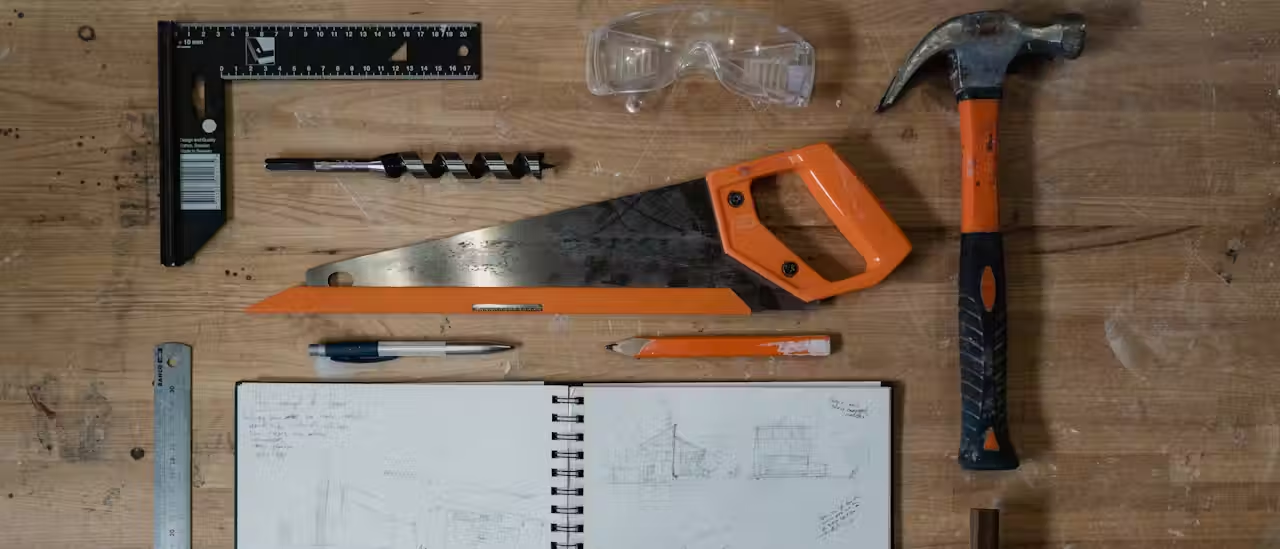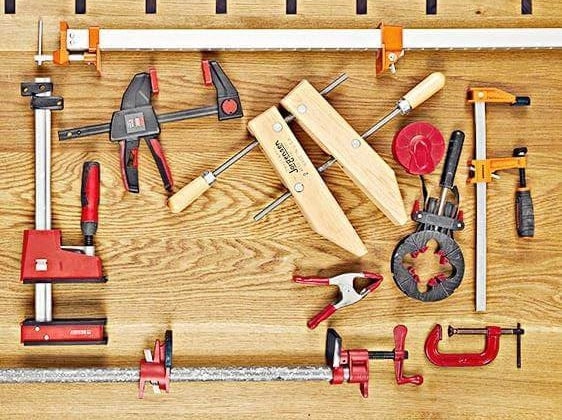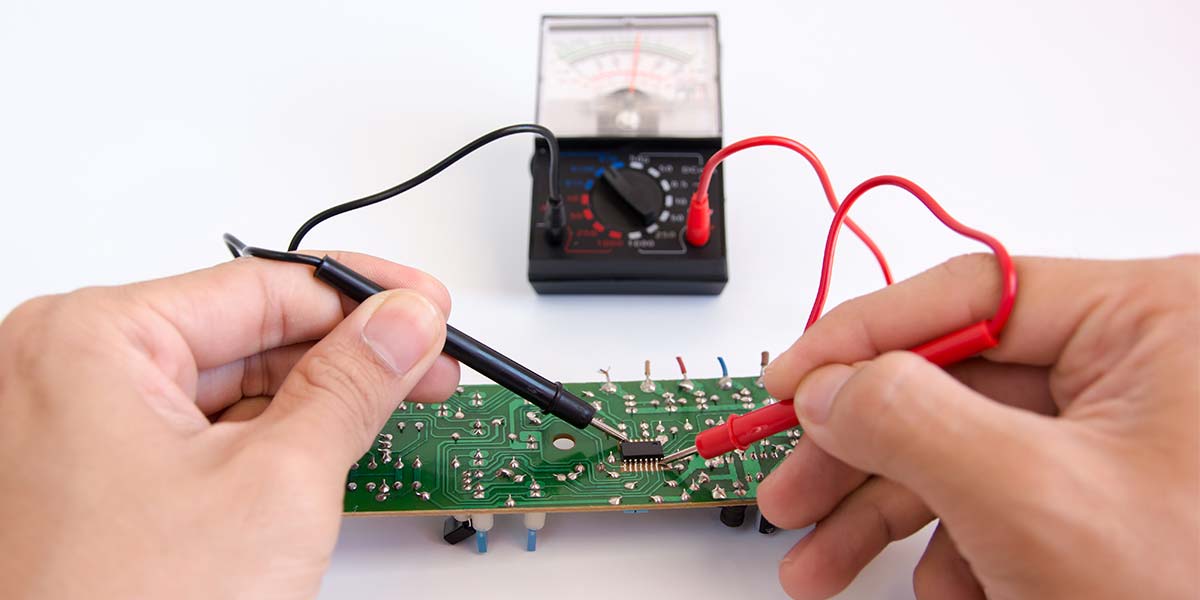News
10 Easy Woodworking Tools for Beginners (Start Your DIY Journey Today!)
Published
6 months agoon
By
Anderson
Woodworking is a rewarding and creative hobby that allows you to bring ideas to life. If you’re just starting out, it can feel overwhelming to choose the right tools, especially with so many options available. But don’t worry! This guide will walk you through the essential woodworking tools for beginners, help you understand their importance, and show you how to start your DIY journey confidently and affordably. Let’s dive in and get started!
What Are Woodworking Tools? (Beginner’s Guide)
Woodworking tools are tools designed to shape, cut, join, or smooth wood to create furniture, crafts, or other items. They come in a wide variety, ranging from simple hand tools like hammers and saws to advanced power tools like drills and sanders. For beginners, starting with basic tools is key, as it helps you learn the fundamentals without being overwhelmed.
The right tools can make your woodworking journey enjoyable and efficient. While advanced tools offer precision and speed, beginner-friendly tools are simpler to use and allow you to develop your skills step by step.
Why Every Beginner Needs the Right Tools
Using the correct tools as a beginner is essential for several reasons. First, the right tools make your work safer. For example, using a handsaw specifically designed for beginners is easier and reduces the chance of accidents compared to using a professional-grade power saw. Second, proper tools ensure better results. When you use a sanding block instead of your hands to smooth out surfaces, your projects look more polished and professional.
Moreover, having the right tools means less frustration. Beginners often lose interest when projects take too long or turn out poorly due to using the wrong tools. With beginner-friendly woodworking tools, you can avoid unnecessary challenges and enjoy the process of learning and creating.
Top 10 Must-Have Woodworking Tools for Beginners
Every woodworker starts somewhere, and these ten tools are perfect for beginners looking to build a strong foundation. Let’s explore each tool and how it can help you kick-start your woodworking projects.

- A Beginner-Friendly Saw
A saw is one of the most basic tools you’ll need for woodworking. For beginners, a hand saw or a jigsaw is ideal. These saws are easy to control and can be used to cut wood into different shapes and sizes.
A hand saw, like a crosscut saw, is perfect for making straight cuts, while a jigsaw allows for curved or intricate designs. Both are affordable and versatile, making them a must-have for any beginner.
- Measuring Tape
Precision is everything in woodworking, which is why a measuring tape is essential. Before cutting or assembling wood, you need to measure accurately to ensure your project turns out as planned. Look for a 25-foot measuring tape with clear markings and a locking mechanism for ease of use.
- Sanding Block or Sandpaper
A smooth finish is what makes your woodworking project stand out, and a sanding block or sandpaper is your go-to tool for achieving that. These tools are affordable and come in different grits (coarseness). Start with medium grit (80-120) to remove rough edges, and then move to fine grit (220-320) for a polished surface.
- Claw Hammer
A claw hammer is a dual-purpose tool that every beginner needs. One side drives nails into the wood, while the other side removes nails or helps pry apart the wood. Choose a lightweight hammer with a comfortable grip to make it easier to handle during long projects.
- Screwdrivers
Screwdrivers are essential for assembling wooden pieces or attaching hardware like hinges or screws. A set of flathead and Phillips screwdrivers is sufficient for most beginner projects. Investing in a screwdriver set with multiple sizes will cover all your basic needs.
Power Drill
A power drill is one of the few power tools that beginners should consider. It allows you to drill holes quickly and drive screws efficiently. Look for a cordless drill with variable speeds, as this offers more flexibility and control for your projects.
- Wood Glue
Wood glue is vital for joining pieces of wood together. It’s a beginner-friendly alternative to nails and screws, especially for smaller projects. Choose a glue specifically made for woodworking, as it forms strong bonds and dries quickly.
Adjustable Wrench
An adjustable wrench is useful for tightening bolts or other fasteners in your projects. Its adjustable head means you can use it for a variety of bolt sizes, making it a versatile addition to your toolkit.
- Square
A square is a tool used to ensure that your cuts and corners are perfectly aligned at 90 degrees. It’s especially useful when building furniture, as crooked edges can ruin your entire project. A speed square is an excellent option for beginners because it’s compact and easy to use.
Workbench or Work Surface
Finally, you need a sturdy surface to work on. A workbench provides stability and support for cutting, assembling, and sanding wood. If a workbench is out of your budget, a solid table or a pair of sawhorses can work just as well.
Affordable Woodworking Tools for a Tight Budget
Starting woodworking doesn’t have to cost a fortune. Many of the tools listed above are affordable and can be purchased at your local hardware store or online. To save even more, consider buying second-hand tools. Yard sales, thrift stores, and online marketplaces like Craigslist often have great deals on lightly used tools.
Additionally, you don’t need to buy all your tools at once. Start with the essentials, such as a saw, hammer, and sanding block, and gradually add more tools as you take on new projects. Look for beginner toolkits that bundle multiple tools together at a lower cost.
How to Choose the Right Woodworking Tools for Beginners
Choosing the right tools is about understanding your needs and preferences. Here are some tips to help you make informed decisions:
- Focus on Versatility: Choose tools that can perform multiple functions. For example, a jigsaw can make both straight and curved cuts, making it more versatile than a hand saw.
- Prioritize Quality: While it’s tempting to buy the cheapest tools, investing in quality ensures they last longer and perform better. Read reviews or ask for recommendations to find reliable brands.
- Start Small: Don’t overwhelm yourself with advanced tools you may not need yet. Begin with the basics, and upgrade as your skills improve.
Safety Tips for Beginner Woodworkers
Woodworking is a fun hobby, but safety should always come first. Here are some essential safety tips for beginners:

Work in a Clean Space
A cluttered workspace increases the risk of accidents. Keep your area clean and organized to prevent tools or materials from getting in the way.
Use Safety Gear
Always wear protective gear such as safety goggles, ear protection, and gloves. Goggles protect your eyes from flying wood chips, while gloves shield your hands from splinters.
Learn How Each Tool Works
Take time to read the instructions or watch tutorials before using any new tool. Understanding how a tool works reduces the chance of accidents and ensures better results.
Easy Beginner Woodworking Projects to Try Today
Ready to put your new tools to use? Here are a few beginner-friendly projects you can start with:
- Birdhouse: A small and simple project that teaches basic cutting, measuring, and assembling skills.
- Wooden Coasters: Perfect for practising sanding and finishing techniques.
- Bookshelf: A slightly more advanced project that helps you learn to join wood and ensure proper alignment.
These projects are not only fun but also practical, giving you confidence as you build your skills.
The Bottom Line
Starting woodworking as a beginner is both exciting and rewarding. With the right tools, a little patience, and some practice, you can create beautiful and functional items from scratch. Focus on building your toolkit with essential, beginner-friendly tools like a saw, measuring tape, and sanding block. Remember to prioritize safety and start small with simple projects to build your confidence.
Now that you’re equipped with knowledge about woodworking tools for beginners, it’s time to start your first project. Happy woodworking!
You may like
News
What Is a Food Grade Trailer? (Easy Guide for Beginners in the USA)
Published
7 minutes agoon
July 9, 2025By
Anderson
If you’ve ever wondered how fresh fruits, milk, juices, or even packaged snacks safely get to your grocery store shelves, the answer often involves a food grade trailer. In the United States, these specialized trailers play a critical role in transporting food items without contamination. In this beginner-friendly guide, we’ll explain what food grade trailers are, why they’re important, and everything else you need to know about them. Whether you’re curious about logistics or planning to get into the food transport business, this guide will make it easy to understand.
What Is a Food Grade Trailer?
A food grade trailer is a type of truck trailer specifically designed and maintained to transport food products safely. Unlike standard freight trailers, food grade trailers meet strict cleanliness and safety standards to ensure that whatever is carried inside stays uncontaminated and fresh. These trailers are built with materials and designs that prevent any form of contamination, including odors, bacteria, and residue from previous loads.
Food grade trailers can be tankers that carry liquids like milk or juices, dry vans for packaged foods, or refrigerated trailers for perishables. To be considered “food grade,” a trailer must pass inspections and comply with regulations set by the U.S. Food and Drug Administration (FDA) and the Food Safety Modernization Act (FSMA).
Why Do We Need Food Grade Trailers?
Transporting food is not as simple as loading boxes onto any truck. Food products can spoil, absorb odors, or even become dangerous if they’re not handled properly. This is where food grade trailers come in. They ensure that food stays clean, fresh, and safe from the time it leaves the producer until it reaches stores or restaurants.
For example, a tanker that once carried fuel cannot be used for milk unless it has been properly cleaned and certified food grade. Without these trailers, cross-contamination could lead to foodborne illnesses and huge public health risks. In short, food grade trailers protect consumers, maintain food quality, and help companies comply with strict food safety laws in the U.S.
Types of Food Grade Trailers
Food grade trailers come in different types, each designed for specific kinds of food products. Choosing the right one depends on what’s being transported, how far it needs to go, and whether temperature control is required. Let’s break down the most common types:
Tanker Trailers
Food grade tanker trailers are stainless steel tanks on wheels. They’re primarily used for transporting bulk liquids like milk, cooking oils, juices, and even liquid sweeteners like corn syrup. These tankers must be insulated to keep the contents at the right temperature and must be thoroughly cleaned between loads to avoid cross-contamination.
The interior of these tankers is smooth and polished to prevent residue from sticking, making cleaning and sanitizing easier. In the U.S., they must meet the 3-A Sanitary Standards for dairy and other liquid foods.
Dry Van Trailers
Dry van trailers are the most common food grade trailers for packaged and non-perishable food items. They are enclosed trailers that protect cargo from outside elements like rain, dust, or pests. These trailers are ideal for products like canned goods, cereals, flour, sugar, and packaged snacks.
To qualify as food grade, a dry van must be free from odors, moisture, and any signs of pest infestation. It must also have smooth, cleanable walls and floors.
Refrigerated Trailers (Reefers)
Refrigerated trailers, or reefers, are essential for transporting perishable foods such as meat, seafood, dairy, and frozen products. These trailers have built-in cooling systems that maintain a specific temperature throughout the journey.
In the U.S., strict rules govern how reefers are maintained and cleaned. Temperature monitoring systems are often installed to ensure food safety during transit. Reefers help prevent spoilage and keep foods fresh from farm to table.
How Are Food Grade Trailers Cleaned?
Cleaning is a critical step for maintaining food grade standards. After each load, trailers must be sanitized to remove residues, odors, and potential contaminants. This process often involves high-pressure washing with hot water, food-safe detergents, and sometimes steam cleaning.
For tanker trailers, the cleaning process is known as a “washout” and is performed at certified wash stations. These stations provide a wash ticket as proof of sanitation, which shippers often require before loading new food cargo. Dry vans and reefers also undergo similar cleaning processes, focusing on floors, walls, and air systems.
Failure to properly clean food grade trailers can result in rejected loads, hefty fines, and even health hazards. That’s why carriers invest in regular cleaning and inspection schedules.
Rules for Food Grade Trailers in the USA
In the United States, the FDA regulates food transportation under the Sanitary Transportation of Human and Animal Food rule, part of the FSMA. This rule sets guidelines for:
- Cleaning and maintenance: Trailers must be regularly cleaned and kept in sanitary condition.
- Temperature control: Reefers must maintain specified temperatures, with records available for inspection.
- Loading and unloading practices: Preventing contamination during these processes is critical.
- Training: Drivers and handlers must be trained in sanitary transportation practices.
Carriers are also responsible for maintaining detailed records of cleaning, maintenance, and temperature monitoring. Non-compliance can lead to penalties or being barred from hauling food loads.
Common Foods Carried in Food Grade Trailers
Food grade trailers carry a wide variety of products across the U.S. Here are some of the most common categories:
Fresh Produce
Fruits and vegetables require clean, pest-free trailers and often temperature control to stay crisp and fresh. Reefers are commonly used for these loads.
Dairy and Beverages
Milk, cream, yogurt, juices, and soft drinks often travel in food grade tanker trailers or reefers. These products are highly sensitive to temperature changes and contamination.
Packaged Snacks
Chips, cookies, cereals, and other shelf-stable foods are typically transported in dry van trailers. Even though these are packaged, cleanliness of the trailer is still essential to prevent exposure to odors, moisture, or pests.
Words About Food Grade Trailers
Food grade trailers are more than just trucks on the highway; they are an integral part of the food supply chain. Without them, maintaining the safety and quality of food during transportation would be nearly impossible. Their design, cleaning processes, and regulatory oversight ensure that when you grab a snack or pour a glass of milk, it’s as fresh and safe as it was at the source.
The Bottom Line
For anyone involved in food logistics, understanding food grade trailers is crucial. These specialized trailers ensure the safe and sanitary transportation of food products across the U.S. From tanker trailers hauling bulk liquids to reefers keeping perishables cold, each type plays a unique role in feeding millions every day. As regulations tighten and consumer expectations rise, the importance of food grade trailers will only grow. Whether you’re a shipper, carrier, or simply curious, knowing how these trailers work gives you a deeper appreciation for the unseen systems that keep our food safe.
News
What Does Most Damage to Circuit Board? Simple Guide for Beginners
Published
11 minutes agoon
July 9, 2025By
Anderson
Circuit boards are the heart of almost every electronic device. From your smartphone to your refrigerator, these tiny green boards hold countless components working together. But they’re also very fragile. Understanding what damages a circuit board the most is key to keeping your devices running longer. In this guide, we’ll explain all the common threats to circuit boards and how you can protect them.
What Damages Circuit Boards the Most?
Circuit boards may look tough, but they’re surprisingly delicate. The most common things that damage them include heat, moisture, static electricity, dust, and even using cheap or low-quality parts. These threats can lead to cracks, corrosion, burnt components, and complete failure of the board.
When a circuit board fails, the device it powers can stop working completely. This is why engineers and technicians always focus on protecting boards during manufacturing and after installation. For the average person, knowing these dangers helps you avoid accidents that can ruin expensive electronics.
Can Heat Destroy a Circuit Board?
Yes, heat is one of the biggest enemies of circuit boards. Excessive heat causes the solder (the tiny metal connections on the board) to soften or melt. It can also damage microchips and make plastic parts brittle. Over time, this heat stress leads to broken connections and permanent damage.
Heat doesn’t only come from external sources like sunlight or a nearby heater. Inside devices, components like processors and power supplies generate heat too. If this heat isn’t managed with fans, heat sinks, or proper ventilation, it can destroy the board slowly.
How Hot is Too Hot for a Circuit Board?
Most circuit boards are designed to handle temperatures up to around 85°C (185°F) for standard consumer electronics. Some industrial boards can handle slightly higher temperatures. But anything above 100°C (212°F) is dangerous and can damage components quickly.
High heat can cause the board to warp or expand. It can also cause “thermal runaway” where heat causes more current to flow, which creates even more heat in a vicious cycle. Even short exposure to extreme temperatures (like leaving your laptop in a car on a hot day) can be enough to harm the board.
Why Overheating Happens So Often
Overheating isn’t rare. It often happens because devices are used in poorly ventilated spaces, clogged with dust, or placed on soft surfaces that block airflow. Gaming consoles, laptops, and routers are all vulnerable if their cooling systems fail. Even a broken fan can lead to overheating in a desktop PC.
Simple Tips to Stop Heat Damage
To avoid heat damage:
- Keep vents clear and never block airflow.
- Regularly clean fans and vents to prevent dust buildup.
- Use devices in air-conditioned spaces if possible.
- Avoid charging or using electronics on soft surfaces like beds.
- Replace thermal paste and faulty fans in aging devices.
Does Water Hurt Circuit Boards?
Absolutely. Water and electronics don’t mix. Even a small amount of moisture can cause short circuits, corrosion, and rust on a circuit board. This is why water-damaged phones and laptops often stop working.
Humidity is also a silent enemy. In damp environments, moisture in the air can settle on the board, leading to slow corrosion over months or years. If you live in a humid area, using a dehumidifier or keeping devices in dry spaces is essential.
How Dust and Dirt Damage Boards
Dust might not seem dangerous, but it’s a major threat to circuit boards. As dust accumulates, it traps heat and blocks ventilation. This causes the device to overheat faster. Dust particles can also absorb moisture from the air, creating a conductive layer that leads to shorts or corrosion.
In environments like workshops or homes with pets, circuit boards are more exposed to dirt, hair, and debris. Over time, this grime can create physical barriers between components and cause them to fail.
Why Clean Boards Last Longer
A clean circuit board runs cooler and stays functional longer. Removing dust and dirt reduces the chance of overheating, corrosion, and even electrical shorts. Regular cleaning is a simple habit that can save you from costly repairs or replacements.
Best Way to Clean a Circuit Board Safely
Cleaning circuit boards isn’t complicated but requires care. Here’s how:
- Turn off and unplug the device. Never clean a live board.
- Use compressed air to blow away loose dust and debris.
- For stubborn grime, use isopropyl alcohol (99%) and a soft brush. Avoid water or household cleaners.
- Be gentle. Pressing too hard can damage delicate components.
- Let it dry completely before turning the device back on.
Never use a vacuum cleaner directly on a circuit board because static electricity from vacuums can harm sensitive components.
Can Static Electricity Kill Circuit Boards?
Yes. Static electricity is invisible but deadly to circuit boards. Even a small static discharge from your finger can fry sensitive microchips. This is why technicians use anti-static wrist straps and mats when working on electronics.
What About Power Surges?
Power surges are sudden spikes in electricity. They often happen during storms or due to unstable power grids. A strong surge can burn components and melt traces on a circuit board instantly. Using surge protectors or uninterruptible power supplies (UPS) helps shield devices from these threats.
Why Quality Matters in Circuit Design
High-quality boards use better materials and designs to resist damage from heat, static, and power fluctuations. Cheap boards often lack proper protective coatings or robust components, making them fail faster under stress.
Are Cheap Parts Bad for Circuit Boards?
Yes, using cheap or counterfeit parts is risky. Low-quality components may not meet safety or performance standards. They can overheat, fail prematurely, or even damage other parts of the circuit. Investing in quality components upfront saves money and headaches in the long run.
The Bottom Line
Circuit boards are the backbone of modern electronics, but they’re vulnerable to heat, moisture, dust, static electricity, and cheap components. By understanding what causes the most damage to circuit boards and taking simple precautions, you can extend the life of your devices and avoid costly repairs. Keep them clean, cool, and protected from environmental threats. Treat your gadgets with care, and they’ll serve you well for years to come.
News
Where to Buy Ilco Key Remotes as General Public (Easy Guide)
Published
16 minutes agoon
July 9, 2025By
Anderson
If you’re searching for where to buy Ilco key remotes as general public in the United States, you’re not alone. Many car owners, locksmiths, and even DIY enthusiasts often wonder how and where they can legally and easily purchase these remotes without needing a dealer license. This easy guide breaks down everything for you step by step, so even a 10-year-old can understand where to get them, what to check before buying, and how to get the best deals online and offline.
Best Places to Buy Ilco Key Remotes in the USA
Ilco key remotes are widely used across the United States for car keys, garage doors, and security systems. But finding the right place to buy them as a member of the general public can sometimes feel confusing. The good news? You don’t need to be a professional locksmith or an authorized dealer to get your hands on Ilco remotes. Whether you’re replacing a lost remote or want a backup, there are plenty of options out there.
In the US, you can buy Ilco remotes from a mix of online retailers, local locksmith shops, and even hardware stores. Each comes with its own pros and cons. Online stores often offer better pricing and larger inventories, while local shops can provide personalized service and instant help with programming. Knowing where to look can save you money and time.
Can the Public Buy Ilco Key Remotes?
This is a common question because Ilco is a trusted name in security products, and some people assume their products are restricted. The answer is simple: yes, the public can buy Ilco key remotes. Ilco does sell directly to locksmiths and authorized dealers, but they also allow their products to be sold on platforms that are accessible to everyone.
However, there’s a catch: while you can purchase the remote, programming it to work with your vehicle or lock system might still require professional tools or help from a locksmith. But don’t worry—many sellers online and offline offer pre-programmed remotes or provide programming guides.
Online Stores That Sell Ilco Remotes
Buying Ilco key remotes online is one of the easiest and most popular options today. You get access to a wide variety of models, competitive pricing, and customer reviews to guide your decision.
Amazon – A Simple Option
Amazon is one of the most convenient places to buy Ilco remotes. You can find a huge selection of both original and compatible remotes. Many listings even include programming instructions or links to video tutorials. Plus, Amazon’s fast shipping options mean you can get your remote within a day or two in most parts of the United States.
You can also check customer reviews to ensure the seller is reputable and the remote is of good quality. Look for listings marked “fulfilled by Amazon” for quicker returns if something doesn’t work as expected.
eBay – Good for Deals
eBay is another great place for people looking for Ilco key remotes, especially if you’re on a budget. You can often find new or slightly used remotes at discounted prices. Auctions may even allow you to score a deal far below retail.
But, be cautious: verify the seller’s rating and make sure the remote is compatible with your specific car model or security system. Some sellers on eBay even offer bulk purchases, which can be handy for small businesses or families needing multiple remotes.
Official Ilco Dealers Online
For those who prefer buying directly from official sources, there are many authorized Ilco dealers online. Websites like Ilco’s official site and affiliated distributor pages sell genuine Ilco remotes. While prices might be a little higher than on Amazon or eBay, you’re guaranteed to receive authentic products with full manufacturer support and warranties.
Local Shops Where You Can Buy Ilco Key Remotes
If you’re not comfortable buying online or need help with programming, your local options are worth exploring. Locksmith shops, hardware stores like Home Depot or Lowe’s, and even some auto parts stores stock Ilco key remotes.
Local locksmiths are particularly helpful because they can assist with cutting and programming the key. While they may charge a bit more than online sellers, the added convenience of walking out with a fully functional remote often makes it worth it.
Another advantage of shopping locally is the ability to ask questions face-to-face and get expert recommendations tailored to your needs.
Tips Before You Buy Ilco Key Remotes
Before buying an Ilco remote, there are a few things you should keep in mind to avoid wasting money or buying the wrong product:
- Check compatibility: Not every Ilco remote works with every vehicle or lock system. Verify your model and year before purchase.
- Buy from trusted sellers: Whether online or offline, stick to sellers with good reputations and positive customer reviews.
- Ask about programming: Some remotes can be programmed at home, while others may require a professional’s help.
- Compare prices: Prices can vary widely between sellers, so shop around to get the best deal.
- Look for warranties: Many reputable sellers offer warranties or return policies.
Are Ilco Remotes Cheaper Online or Offline?
This is a question many buyers have, and the answer depends on a few factors. In general, online prices tend to be lower because sellers have less overhead. But buying offline has its own advantages, like instant service and assistance.
Check Compatibility
Online listings often list all compatible models in the description. Make sure your car’s make, model, and year are supported. If in doubt, contact the seller directly before buying.
Compare Prices Online
Shopping online allows you to quickly compare prices between Amazon, eBay, and official Ilco dealers. Look for free shipping offers, coupons, or bulk discounts.
Look for Warranties
When buying online, always check if the seller offers a warranty or satisfaction guarantee. Some online marketplaces provide 30-day return policies, but official dealers often include a manufacturer’s warranty that covers defects.
Thoughts – Buying Ilco Remotes Made Easy
Buying Ilco key remotes as a member of the general public is not as difficult as it might seem. Thanks to a wide range of online and offline options, you can easily find and purchase the right remote for your needs. Just remember to double-check compatibility, read reviews, and choose a trusted seller.
The Bottom Line
If you’re in the United States wondering where to buy Ilco key remotes as general public, the answer is simple: you have plenty of options. From Amazon and eBay to local locksmiths and official Ilco dealers, you can shop where it’s most convenient for you. Take a little time to research, and you’ll have your new remote in hand quickly and at the best possible price.

What Is a Food Grade Trailer? (Easy Guide for Beginners in the USA)

What Does Most Damage to Circuit Board? Simple Guide for Beginners

Where to Buy Ilco Key Remotes as General Public (Easy Guide)

TuGuiaUSA.com, Empleos y Oportunidades en USA

Camille Monfort, Shadows of the Crimson Moon

Breaking News: Tea Leoni and Tim Daly Announce Split
Trending
-

 Business7 months ago
Business7 months agoTuGuiaUSA.com, Empleos y Oportunidades en USA
-

 Life Style7 months ago
Life Style7 months agoCamille Monfort, Shadows of the Crimson Moon
-

 Life Style7 months ago
Life Style7 months agoBreaking News: Tea Leoni and Tim Daly Announce Split
-

 Games7 months ago
Games7 months agoUnlocking Access to Unblocked Games World at School
-

 Life Style7 months ago
Life Style7 months agoJulio Urias Wife: Inside His Life with Daisy
-

 Life Style7 months ago
Life Style7 months agoIgAnony: The Anonymous Instagram Story Viewer
-

 Life Style7 months ago
Life Style7 months agoMichael Ciminella: Biography, Age, Net Worth & Career Highlights
-

 Education7 months ago
Education7 months agoTribute Printed Pics: A Special Way to Remember
